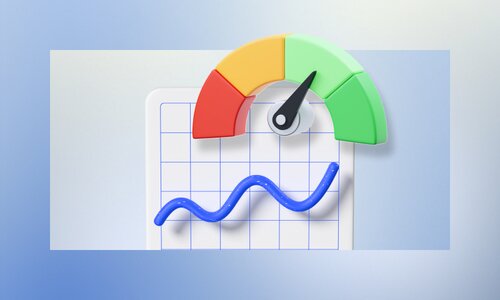Saving money is at the top of the list of personal finance goals for most people. It can sometimes feel challenging to make progress, especially during high inflation rates and a cost of living crisis — but it is possible.
Whether you’re looking to build up your emergency fund, save for a specific purchase, or improve your overall financial well-being, finding ways to save more money is essential.
1. Create a designated savings account
To become an effective saver, it’s crucial to have a designated savings account that’s separate from your daily spending. This keeps you from dipping into your savings for day-to-day expenses.
You can automate your savings by automatically transferring a portion of your paycheck into your savings account. This ensures that you’re paying yourself first each month and prioritizing savings while reducing the temptation to spend the money on other expenses. For an added boost, consider using a high-yield savings account that offers competitive interest rates.
2. Create a budget
To save money quickly, it’s important to master the art of budgeting. By gaining control over your spending habits, you’ll quickly gain control over your finances. Start by understanding your cash flow, including income, fixed monthly bills, student loan repayments, cellphone charges, and Individual Retirement Account (IRA) or 401(k) contributions. Utilizing online banking services allows you to conveniently track your expenses, set savings goals, and automate transfers, making it easier to save money and achieve your financial targets.
Try these popular budgeting methods:
- Zero-based budgeting: Allocates every dollar of your income toward a specific purpose, ensuring that your income minus expenses equals zero.
- 50/30/20 budgeting: This method divides your after-tax income into three categories: 50% for needs (essential expenses, such as housing and utilities), 30% for wants (non-essential expenses, such as entertainment), and 20% for savings and debt repayment.
- Envelope system: This method requires you to assign cash into different envelopes labeled with specific spending categories. You can only spend the money in each envelope for its designated purpose.
- Pay yourself first: Prioritize saving by setting aside a portion of your income for savings or investments before allocating funds for other expenses.
- 80/20 budgeting: This method involves allocating 80% of your income towards expenses and using the remaining 20% for savings, investments, and debt repayment.
- Value-based budgeting: A value-based budget aligns your spending with your core values and long-term goals. With this method, you’ll identify your priorities and allocate resources accordingly.
- Digital budgeting: Using budgeting apps can simplify the process by syncing with your accounts and providing real-time insights into your finances.
3. Cancel unused subscriptions
Review your monthly bank statements to identify and cancel unused subscriptions or memberships. For example, if you’re signed up to streaming services such as Netflix, Hulu, or Amazon Prime, and of course, gym memberships and subscription boxes, pick out the ones you’re not using and unsubscribe from each. Also, disable auto-renewal.
4. Cut down on your grocery bill
One of the most popular ways to save money on a tight budget is to reduce your grocery bill. Here’s how to spend less money when grocery shopping:
- Look for cheaper products on lower shelves in supermarkets.
- Consider going meat-free at least once a week.
- Buy generic brands for medicine, staple food items, cleaning supplies, and paper products. Brand names often have higher prices without significant differences in quality.
- Avoid food waste by making a shopping list and planning your meals.
- Use coupons from newspapers, magazines, grocery store ads, retailer websites, email subscriptions, and coupon websites or apps.
- Take advantage of seasonal sales to get better deals on big-ticket items.
- Go with a fixed amount of cash. This will help you avoid impulse buys and splurges at checkout and keep an eye on how much money you have left as you add items to your basket.
5. Reduce your utility bills
Cutting back on utility bills is an effective way to save money on your monthly expenses. To do so:
- Compare energy providers to ensure you’re on the cheapest plan available.
- Swap your light bulbs for energy-efficient LED bulbs. This saves the average household $225 in electric bills per year, according to the U.S. Department of Energy.
- Invest in a smart thermostat to adjust your central heating and reduce energy consumption automatically.
- Seal air leaks around windows and doors to prevent warm air from escaping and increase heating efficiency.
- Practice energy-saving habits like taking shorter showers, washing clothes in cold water, and unplugging small appliances when not in use.
- Be mindful of water usage, fix leaky pipes, and consider installing water-saving devices.
6. Get out of high-interest debt
High monthly debt payments can hinder your ability to save money, so it’s crucial to prioritize eliminating outstanding balances before or as you start saving. Start by paying off outstanding balances to avoid accumulating more interest over time. Also, consider transferring any credit card debt to a 0% balance card and making regular payments within the promotional period. If you come into extra cash, such as a work bonus or tax refund, use it to pay off high-interest debt. You may also want to set spending limits on your credit or debit cards to prevent overspending.
7. Ask for discounts
Take advantage of discounts whenever they’re available. Whether it’s a promotional discount or a special low-cost offer for certain groups like seniors, students, teachers, or military personnel, make it a habit to inquire about potential savings. When you get a discount and save a percentage, transfer that saved amount directly into your savings account. By doing so, you immediately allocate those savings towards building your financial reserves.
8. Adjust your tax withholdings
If you receive a large tax refund each year, it may be beneficial to adjust your tax withholdings. Instead of allowing the government to hold on to your excess money through the year, adjusting your withholdings ensures you keep more of your hard-earned income. Direct the funds towards savings and investments.
9. Check insurance rates
One effective way to save money is by regularly checking and reviewing your insurance rates. Insurance premiums can make up a significant portion of your monthly expenses, so it’s important to ensure you get the best possible rates. Here’s how to save money on insurance:
- Shop around for competitive quotes: Request quotes for home insurance, car insurance, and other types of insurance you currently hold. See if you can find a better deal elsewhere.
- Review your coverage needs: As your circumstances change, so do your insurance needs. Take a closer look at your policies to ensure you have the appropriate coverage for your current situation.
- Bundle your policies: Many insurance companies offer discounts when you bundle multiple policies, such as combining your home and auto insurance.
- Increase deductibles: A higher deductible means you’ll have to pay more out of pocket in the event of a claim, but it can lower your premiums and save you money in the long run.
- Maintain a good credit score: Your credit score can impact your insurance rates. Maintaining a good credit score can help you secure lower rates.
10. Refinance your mortgage
Refinancing your mortgage can be a smart financial move that helps you save money in the long term. Here are some key points to consider when it comes to refinancing your home:
- Lower interest rate: One of the main reasons to refinance is to secure a lower interest rate. If current mortgage rates are lower than what you signed up for, finding a lender who offers competitive rates can result in significant savings over the life of your home loan.
- Shorter loan term: You can also refinance to a shorter-term mortgage, such as moving from a 30-year loan to a 15-year loan. While your monthly payments may increase, the overall interest savings can be substantial.
- Change from an adjustable-rate to a fixed-rate mortgage: Refinancing from an adjustable-rate mortgage to a fixed-rate mortgage can provide stability and protect you from potential interest rate hikes in the future.
- Eliminate PMI: If you have a mortgage with less than a 20% down payment, you’ll likely be paying PMI or Private Mortgage Insurance as part of your monthly payment. If you’ve built up enough equity in your home, refinancing can help you eliminate the PMI and reduce your bill.
11. Save on rent
If you’re renting, research and compare rental prices in different neighborhoods and areas to see if you can get better deals. Compare the costs of similar properties and consider locations that offer more affordable options. If you’d like to stay put and have an excellent rental history, ask your landlord or property manager if they’re open to offering discounts or incentives for a long-term stay.
12. Take the DIY approach
You can also save money by embracing DIY and fixing things yourself. YouTube tutorials and instructional articles can teach you to do odd jobs around the house, such as fixing leaky pipes or cleaning the rain gutters. Doing it yourself can be more cost-efficient than hiring someone or buying replacements. If you can, borrow tools from friends or neighbors instead of purchasing them for one-time use.
13. Have fun with savings challenges
Building your savings is a long-term project, and you need to maintain consistency and momentum if you are to have success with your savings plan. Try making it fun through mini-challenges and games.
For example, you could do a 30-day savings challenge to remove one nonessential spend, such as a cup of coffee or clothing purchase, and add the amount saved to your savings account. Do this daily for 30 days and see how much you can add up. Or challenge yourself to save an additional 1% of your salary each month for the next six months. Another popular challenge is the 52-week savings challenge, in which you save a specific amount weekly for an entire year.
Take the next step towards your financial future with Arrived
Once you’ve established a solid financial foundation by paying off your debt and building an emergency fund, investing in real estate can be a powerful strategy for growing wealth.
Arrived is a platform offering an opportunity to invest in real estate. Instead of purchasing a single home, Arrived allows you to invest in a variety of residential properties across different markets, potentially reducing the financial commitment and maintenance challenges associated with owning a single property.
The opinions expressed in this article are for general informational purposes only and are not intended to provide specific advice or recommendations for any individual or on any specific security or investment product. The views reflected in the commentary are subject to change at any time without notice. View Arrived’s disclaimers.








